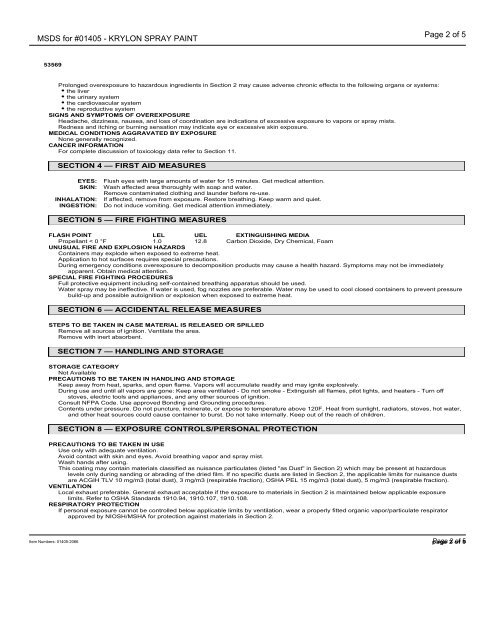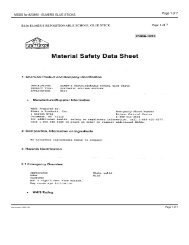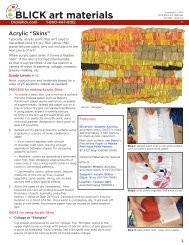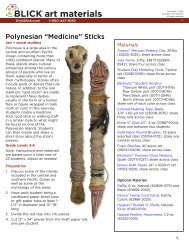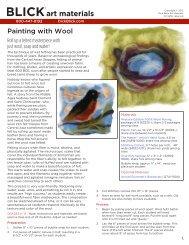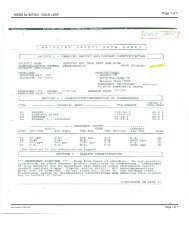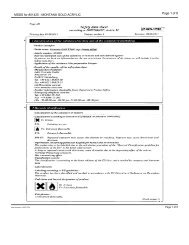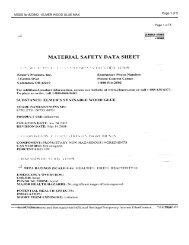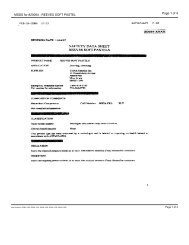MSDS for #01405 - KRYLON SPRAY PAINT - Dick Blick
MSDS for #01405 - KRYLON SPRAY PAINT - Dick Blick
MSDS for #01405 - KRYLON SPRAY PAINT - Dick Blick
Create successful ePaper yourself
Turn your PDF publications into a flip-book with our unique Google optimized e-Paper software.
<strong>MSDS</strong> <strong>for</strong> <strong>#01405</strong> - <strong>KRYLON</strong> <strong>SPRAY</strong> <strong>PAINT</strong><br />
Page 2 of 5<br />
53569<br />
Prolonged overexposure to hazardous ingredients in Section 2 may cause adverse chronic effects to the following organs or systems:<br />
the liver<br />
the urinary system<br />
the cardiovascular system<br />
the reproductive system<br />
SIGNS AND SYMPTOMS OF OVEREXPOSURE<br />
Headache, dizziness, nausea, and loss of coordination are indications of excessive exposure to vapors or spray mists.<br />
Redness and itching or burning sensation may indicate eye or excessive skin exposure.<br />
MEDICAL CONDITIONS AGGRAVATED BY EXPOSURE<br />
None generally recognized.<br />
CANCER INFORMATION<br />
For complete discussion of toxicology data refer to Section 11.<br />
SECTION 4 — FIRST AID MEASURES<br />
EYES:<br />
SKIN:<br />
INHALATION:<br />
INGESTION:<br />
Flush eyes with large amounts of water <strong>for</strong> 15 minutes. Get medical attention.<br />
Wash affected area thoroughly with soap and water.<br />
Remove contaminated clothing and launder be<strong>for</strong>e re-use.<br />
If affected, remove from exposure. Restore breathing. Keep warm and quiet.<br />
Do not induce vomiting. Get medical attention immediately.<br />
SECTION 5 — FIRE FIGHTING MEASURES<br />
FLASH POINT<br />
LEL UEL EXTINGUISHING MEDIA<br />
Propellant < 0 °F<br />
1.0<br />
12.8 Carbon Dioxide, Dry Chemical, Foam<br />
UNUSUAL FIRE AND EXPLOSION HAZARDS<br />
Containers may explode when exposed to extreme heat.<br />
Application to hot surfaces requires special precautions.<br />
During emergency conditions overexposure to decomposition products may cause a health hazard. Symptoms may not be immediately<br />
apparent. Obtain medical attention.<br />
SPECIAL FIRE FIGHTING PROCEDURES<br />
Full protective equipment including self-contained breathing apparatus should be used.<br />
Water spray may be ineffective. If water is used, fog nozzles are preferable. Water may be used to cool closed containers to prevent pressure<br />
build-up and possible autoignition or explosion when exposed to extreme heat.<br />
SECTION 6 — ACCIDENTAL RELEASE MEASURES<br />
STEPS TO BE TAKEN IN CASE MATERIAL IS RELEASED OR SPILLED<br />
Remove all sources of ignition. Ventilate the area.<br />
Remove with inert absorbent.<br />
SECTION 7 — HANDLING AND STORAGE<br />
STORAGE CATEGORY<br />
Not Available<br />
PRECAUTIONS TO BE TAKEN IN HANDLING AND STORAGE<br />
Keep away from heat, sparks, and open flame. Vapors will accumulate readily and may ignite explosively.<br />
During use and until all vapors are gone: Keep area ventilated - Do not smoke - Extinguish all flames, pilot lights, and heaters - Turn off<br />
stoves, electric tools and appliances, and any other sources of ignition.<br />
Consult NFPA Code. Use approved Bonding and Grounding procedures.<br />
Contents under pressure. Do not puncture, incinerate, or expose to temperature above 120F. Heat from sunlight, radiators, stoves, hot water,<br />
and other heat sources could cause container to burst. Do not take internally. Keep out of the reach of children.<br />
SECTION 8 — EXPOSURE CONTROLS/PERSONAL PROTECTION<br />
PRECAUTIONS TO BE TAKEN IN USE<br />
Use only with adequate ventilation.<br />
Avoid contact with skin and eyes. Avoid breathing vapor and spray mist.<br />
Wash hands after using.<br />
This coating may contain materials classified as nuisance particulates (listed "as Dust" in Section 2) which may be present at hazardous<br />
levels only during sanding or abrading of the dried film. If no specific dusts are listed in Section 2, the applicable limits <strong>for</strong> nuisance dusts<br />
are ACGIH TLV 10 mg/m3 (total dust), 3 mg/m3 (respirable fraction), OSHA PEL 15 mg/m3 (total dust), 5 mg/m3 (respirable fraction).<br />
VENTILATION<br />
Local exhaust preferable. General exhaust acceptable if the exposure to materials in Section 2 is maintained below applicable exposure<br />
limits. Refer to OSHA Standards 1910.94, 1910.107, 1910.108.<br />
RESPIRATORY PROTECTION<br />
If personal exposure cannot be controlled below applicable limits by ventilation, wear a properly fitted organic vapor/particulate respirator<br />
approved by NIOSH/MSHA <strong>for</strong> protection against materials in Section 2.<br />
Item Numbers: 01405-2066 page Page 2 of 5


